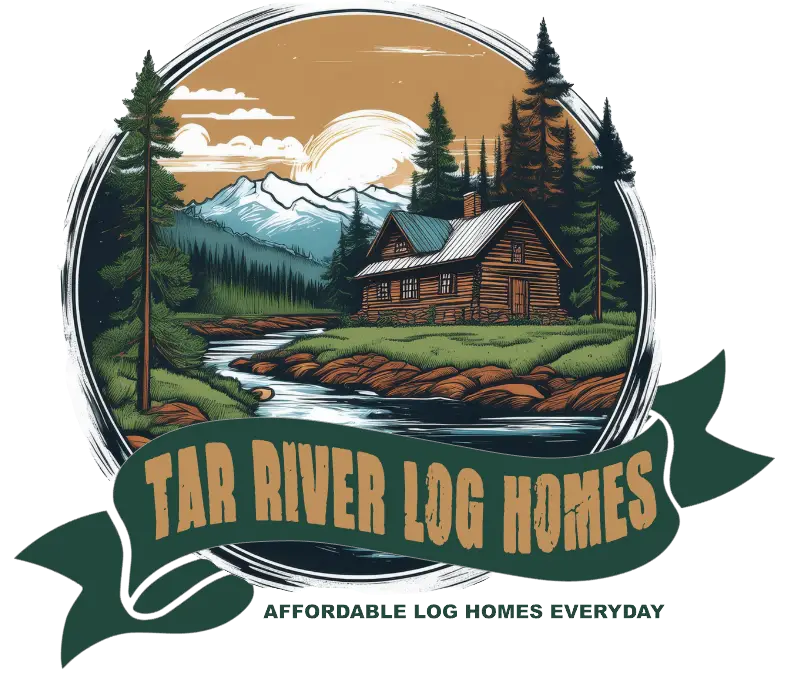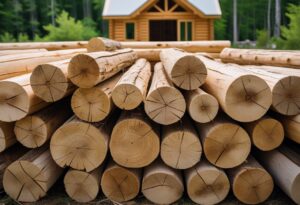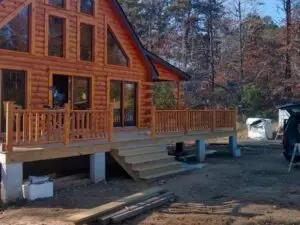Choosing the right logs can make or break your cabin project. Kiln-dried logs stand out because they offer stability, strength, and energy efficiency. Unlike raw or air-dried wood, kiln-dried logs resist warping, cracking, and insect damage. They also make building smoother and faster.
Families appreciate that these logs improve comfort while reducing maintenance needs. Fewer surprises mean more time enjoying your cabin. At Tar River Log Homes, we believe in affordable, honest solutions for building strong cabins that last.
This guide explores the many benefits of kiln-dried logs for your cabin, along with practical buying and care tips.
What Are Kiln-Dried Logs?
Kiln-dried logs are wood that has undergone a controlled drying process to reduce moisture content. This process affects the wood’s stability, durability, and suitability for building or burning.
Knowing how kiln drying differs from other methods helps you choose the right logs for your cabin.
Definition and Process
Kiln-dried logs are dried in a heated chamber called a kiln. The wood is exposed to controlled heat and airflow, reducing its internal moisture content to about 6-10%.
This drying method is faster compared to traditional air drying, which can take months. Kiln drying also uses dehumidifiers to remove moisture-laden air, ensuring even drying throughout the log.
Because the process is carefully managed, the logs become more dimensionally stable. This minimizes shrinking, warping, or cracking after installation.
Differences From Seasoned Logs
Seasoned logs, or air-dried logs, dry naturally outdoors over several months or even years. They usually retain more moisture, typically around 15-20%.
Air-dried logs can be affected by weather, insects, and fungi during this slower drying process. Kiln-dried logs, in contrast, are “pre-shrunk” and have a more uniform moisture content, reducing the risks of damage or deformation once built into your cabin.
Kiln drying also eliminates bugs, mold, and spores due to the elevated heat. Air drying cannot guarantee this as effectively.
Benefits Over Other Types of Firewood
Kiln-dried logs ignite more easily and burn more efficiently because they have less moisture. This means better energy savings and cleaner burning, with less smoke and creosote buildup.
They are also cleaner to handle, with fewer insects or mold spores. Kiln-dried logs provide more uniformity in size and shape, which is helpful if you’re building a cabin. This ensures tighter joints and less settling over time.
Why Choose Kiln-Dried Logs for Cabins
Kiln-dried logs offer advantages in heat efficiency, indoor comfort, and maintenance. Their low moisture content leads to cleaner burning and a more stable cabin environment. These features make kiln-dried logs a smart choice for your cabin build.
Improved Heating Efficiency
Kiln drying reduces the moisture content in logs to around 15% or less. Lower moisture means your fire uses less energy to evaporate water, so more heat warms your cabin.
You’ll notice faster ignition and longer-lasting coals compared to air-dried or green wood. This translates to better fuel efficiency and less wood burned overall.
Additionally, kiln-dried logs provide consistent performance. Since they are pre-shrunk and stable, your wood supply will behave predictably during heating seasons.
Enhanced Comfort and Ambiance
With kiln-dried logs, you get cleaner, steadier fires. Less moisture means fewer pops and less crackling noise, creating a calm and relaxing atmosphere.
The reduced moisture also limits the growth of mold and fungi inside your cabin walls. This supports better air quality, helping you breathe easier.
Because kiln drying removes resin and stabilizes the wood, the logs are less likely to warp or shrink unexpectedly. This keeps your cabin’s interior tight and draft-free for a cozier feel.
Reduced Smoke and Creosote
Burning kiln-dried logs produces less smoke than wetter wood. This happens because the wood burns hotter and cleaner with less trapped moisture.
Less smoke means your chimney will accumulate creosote more slowly. Creosote buildup is a major cause of chimney fires, so kiln-dried logs contribute to safer home maintenance.
You’ll find that stove and chimney cleaning becomes easier and less frequent. This saves you time and reduces the risk of costly repairs down the line.
Health Benefits of Cleaner Indoor Air
Wood burning impacts indoor air quality. The U.S. Environmental Protection Agency (EPA) notes that wet wood creates more smoke, which increases exposure to fine particulates and indoor pollutants.
Kiln-dried logs burn cleaner with less smoke, which reduces these risks. Families benefit from healthier air inside the cabin, especially for children, elderly members, or anyone with respiratory concerns.
Selecting the Best Kiln-Dried Logs
Choosing the right Kiln-dried logs means focusing on wood type, size, quality indicators, and where the logs come from. Picking carefully will help you get efficient heat, easy lighting, and a clean burn in your cabin stove or fireplace.
Wood Species Overview
Different wood species offer distinct benefits. Ash and birch are popular choices because they ignite quickly and produce consistent, bright flames.
Birch also gives off a pleasant aroma, enhancing your cabin’s cozy feel. Hardwoods like oak burn longer and generate more heat, but can be tougher to light initially.
Softwoods, while easier to ignite, tend to burn faster and leave more residue. Your choice depends on whether you prioritize warmth duration or ease of starting the fire.
Optimal Log Sizes for Cabin Stoves
For most cabin stoves, logs sized between 20 to 30 cm (8 to 12 inches) are ideal. This length fits well in standard stoves and promotes efficient combustion.
Thicker logs burn longer but need more air to keep going. If you have a smaller stove or fireplace, you might prefer thinner logs, around 10 to 15 cm (4 to 6 inches), for quicker kindling and shorter burn times. Consistent sizing ensures steady heat and easier loading.
How to Identify Quality Logs
Look for wood with a moisture content below 20%. Kiln drying lowers moisture well past what natural seasoning achieves.
Dry logs should feel lighter, have cracks at the ends, and produce a hollow sound when tapped together. Avoid logs with green or moldy patches—they indicate poor drying or storage.
The bark should be intact but loose, and the wood should have a fresh, clean scent without signs of rot. These signs ensure the logs will burn efficiently and cleanly.
Certifications and Sourcing
Choose kiln-dried logs from suppliers who follow sustainable forestry practices. Certifications like FSC (Forest Stewardship Council) or PEFC (Programme for the Endorsement of Forest Certification) verify that the timber is responsibly sourced.
Buying from certified suppliers supports environmental care and guarantees better quality. Local sourcing, when possible, also reduces transportation emissions and ensures fresher wood.
Storing and Handling Kiln-Dried Logs in Cabins
To keep your kiln-dried logs in great shape, focus on choosing the right spot, stacking them properly, and protecting them from moisture. These steps help maintain dryness and improve burning efficiency.
Ideal Storage Conditions
Store your kiln-dried logs in a dry, well-ventilated area that stays sheltered from rain, snow, and humidity. Keep logs off the ground using a raised platform or pallets to avoid moisture creeping in from the soil.
A covered wood store with a sloped, waterproof roof works best. It protects logs without trapping moisture, allowing air to circulate freely around them. Avoid plastic covers that can cause condensation and promote mold. If storing indoors, pick a cool, dry room with plenty of airflow.
Avoid damp basements or areas prone to temperature swings, which can cause logs to warp or absorb moisture again.
Stacking Techniques
Stack your logs in neat rows with some space between pieces for airflow. Position logs so air can pass through the stack horizontally and vertically.
Use a crisscross pattern at the ends of the pile to add stability and improve ventilation. Keep the stack compact to reduce exposure, but not so tight that air can’t circulate. Always face the cut ends of logs outward. This exposes the wood’s drying surface, making sure moisture escapes quickly.
Preventing Moisture Reabsorption
Even kiln-dried logs can absorb moisture if not handled right. Keep your logs covered during wet weather with a waterproof roof, but allow air to flow below and around the stack. Rotate your woodpile regularly. Use older logs first and add fresh ones to the back or bottom.
This setup prevents logs from sitting too long and absorbing humidity. Inspect your logs occasionally for signs of mold or dampness. If you notice any wet spots, increase ventilation or move the stack to a drier location.
Using Kiln-Dried Logs in Cabin Wood Stoves and Fireplaces
Kiln-dried logs offer a cleaner and more efficient burn in your cabin wood stove or fireplace. Their low moisture content means they ignite faster and produce more heat while reducing creosote buildup.
Proper lighting, regular maintenance, and safety measures are essential to get the best performance from these logs.
Lighting and Burning Tips
Start with small kindling and dry paper to create a hot base for your kiln-dried logs. Because these logs have moisture levels usually below 20%, they catch fire quickly.
Avoid overstacking to ensure good airflow. Place logs loosely to allow oxygen to circulate—this helps the fire burn hotter and reduces smoke.
Avoid burning wood that’s too small or dust-like, as it can cause rapid flames and less consistent heat. Remember to open the damper fully when lighting to provide maximum draft. Once the fire is stable, adjust to control the burn rate without smothering the fire.
Maintaining Your Wood Stove
Regular cleaning is key when using kiln-dried wood because the lower moisture reduces creosote but doesn’t eliminate it. Check ash build-up after every few burns and empty it before it reaches the ash pan’s edge.
Inspect the stove glass weekly. Kiln-dried wood produces less smoke residue, but soot can still accumulate, affecting visibility and efficiency.
Use stove glass cleaner designed for fireplaces. Annual professional inspections and chimney sweeps ensure your system is free of dangerous blockages or creosote buildup. This keeps your stove running safely and efficiently.
Safety Considerations
Always maintain proper clearance between the stove and surrounding combustibles. Kiln-dried logs burn hotter and more consistently, so your stove and chimney need to be in good condition to handle the heat.
Use a sturdy fireplace screen to prevent sparks from escaping. Keep a working smoke and carbon monoxide detector nearby.
Store kiln-dried logs away from the stove but in a dry space to preserve their low moisture content. Never use flammable liquids to start or speed up your fire.
Sustainability and Environmental Benefits
Kiln-dried logs offer eco-friendly advantages that align with responsible wood sourcing and reducing your cabin’s carbon footprint. Their use helps you build efficiently while supporting sustainable forestry and energy-conscious choices.
Ethical Sourcing Practices
When you choose kiln-dried logs, you’re often selecting wood from sustainably managed forests. This means the trees are harvested in ways that allow forests to regrow naturally, keeping ecosystems balanced.
Kiln drying itself supports this ethic by maximizing the logs’ lifespan and usability. It removes moisture safely without harmful chemicals, reducing waste because the logs are less likely to rot or attract pests.
Many suppliers follow certifications, ensuring the wood comes from responsibly managed lands. By buying kiln-dried logs with such certifications, you contribute to forest conservation and promote long-term wood supply sustainability.
Lowering Your Cabin’s Carbon Footprint
Kiln drying decreases the moisture content in logs efficiently, which allows for cleaner and more complete burning if you use wood as fuel. This translates to fewer emissions compared to burning green or air-dried logs.
The energy used in kiln drying is offset over time because dry logs burn hotter and longer, meaning you use less wood and produce less smoke.
Since trees absorb carbon as they grow, using logs from sustainably managed forests means the carbon released when the wood burns is part of a natural cycle.
By integrating kiln-dried logs into your cabin project, you support a renewable resource and promote reduced greenhouse gas emissions through smarter energy use.
Where to Buy Kiln-Dried Logs for Cabins
For high-quality kiln-dried logs at wholesale prices, a trusted company offers reliable options for families and cabin builders. We provide only the best products for your log home, focusing on affordability and transparency.
Choosing kiln-dried logs from a reputable provider means you get dependable quality and support from people who care about helping you build your dream cabin.
Local Suppliers
Local sawmills and log home supply stores often carry kiln-dried logs and can provide hands-on advice. You can inspect the logs before buying to check moisture content and quality.
Many local mills offer Eastern White Pine logs kiln-dried to about 18% moisture, which is ideal for stable construction. Buying locally may reduce shipping costs and allow faster delivery.
Some suppliers also offer custom milling services, so you can get logs cut to your specifications. Visiting the site can help you build a relationship with the supplier, which is useful for future orders or troubleshooting.
Online Sources
Online retailers provide a broad selection of Kiln-dried logs, including specialty profiles and lengths. You can compare prices and read reviews before buying. Websites often list moisture content, wood species, and dimensions clearly.
Some companies offer nationwide shipping, which may come with higher fees but expands your options. Look for sellers that provide detailed product descriptions and kiln-drying certifications for reliability.
Bulk Ordering Advice
When ordering logs in bulk, planning and communication are essential to avoid surprises. Calculate the exact number of logs needed based on your cabin design, factoring in waste and cuts. Confirm moisture content and drying methods to ensure uniformity across shipments.
Discuss delivery logistics beforehand. Bulk orders may require scheduling for unloading and on-site storage. Some suppliers offer discounts for large quantities, but check the return policy carefully.
Also, verify if the supplier can provide support or replacement logs if any issues arise during construction.
Cost Considerations
When planning your cabin build, understanding the expenses related to kiln-dried logs is important. You’ll want to weigh options carefully, look at what drives prices up or down, and find ways to make the most of your budget while getting quality materials.
Price Comparison With Alternatives
Kiln-dried logs typically cost more than air-dried or green logs. Expect to pay around $15-$30 per linear foot for kiln-dried pine logs compared to as little as $1-$3 per board foot for raw, untreated logs.
The extra cost reflects benefits like reduced shrinkage, fewer pests, and quicker drying times. Standard air-dried logs can have more moisture and may require longer settlement periods after construction, which can add to overall costs. You should also consider transportation.
Kiln-dried logs often weigh less due to lower moisture content, but delivery fees can still add significantly, depending on your location.
Factors Influencing Cost
Several things affect the price of kiln-dried logs. Log species matters—Eastern White Pine is common and somewhat affordable compared to hardwoods. Log length and profile type play a role, too.
You can choose between single or double tongue-and-groove (T&G) systems, which vary in price based on complexity. Longer logs or specialty milling add to costs. Drying to about 18% moisture content demands energy, adding to the price.
Quality controls like insect elimination and resin drying also mean kiln-dried logs cost more but deliver better durability.
Getting the Best Value
To get the most value, compare vendors on both price and quality guarantees. Some suppliers offer assurances that cover shortages or defects without extra fees, which can save money long-term. Ordering logs in bulk or by lineal foot may lower per-unit prices.
Be sure to check if delivery and handling fees are included or extra. Consider how long you want your cabin to last with minimal maintenance. Spending more upfront on kiln-dried, precision-milled logs often means fewer repairs and better energy efficiency.
Building Better Cabins With Kiln-Dried Logs
Kiln-dried logs offer durability, stability, and efficiency that air-dried wood simply can’t match. They create stronger, safer cabins while reducing maintenance and long-term costs.
At Tar River Log Homes, we believe families deserve reliable building materials that keep the cabin experience simple, affordable, and lasting.
Ready to start your cabin build? Explore our kiln-dried log options today and see how easy it is to create a strong, beautiful home that lasts for generations.
Frequently Asked Questions
You’ll learn about the best wood types for cabins, where to buy kiln-dried logs, and budgeting for materials. There are also tips for finding affordable logs and options for replacement logs if needed.
What are the best types of wood for constructing a log cabin?
Eastern White Pine is highly recommended for log cabins because of its durability, appearance, and consistent availability. Other popular options include Douglas Fir and Cedar, known for their strength and resistance to decay.
Where can I find kiln-dried logs specifically for cabin building?
You can find kiln-dried logs at specialized log home suppliers and lumberyards that stock logs dried to about 15-18% moisture content. Some companies offer next-day shipping of kiln-dried logs suitable for cabin construction.
How much can I expect to spend on kiln-dried logs for a 2000 sq ft cabin?
Costs vary depending on wood type and supplier. A rough estimate is several thousand dollars for quality kiln-dried logs. Prices can range significantly based on location and the specific log dimensions you require.
What are some tips for finding affordable or free logs for building a log home?
Look for local tree removal services or sawmills that might give away or sell logs at reduced prices. Networking with landowners or checking online community boards can also lead to affordable or free log sources.
Can I purchase replacement logs for my log home, and if so, where?
Yes, many suppliers specialize in replacement logs matched to your original wood type and size. Some manufacturers offer hybrid-dried logs that balance natural drying with kiln finishing for durability.
Tar River Log Homes is here to help you find the right kiln-dried logs for your cabin project. We provide only the best products for your log home.
Are there any reliable online marketplaces for buying cabin logs?
Yes, there are online platforms dedicated to log home materials where you can buy kiln-dried logs. These sites often provide detailed product info and shipping options to help you source what you need remotely.
Tar River Log Homes offers high-quality log home materials with a focus on affordability and transparency.




